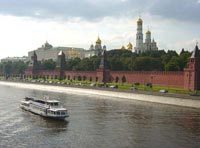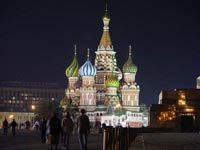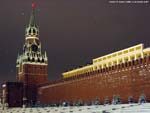
Moscow Kremlin is a group of fortifications and civic and religious buildings in the heart of Moscow, opposite the Moscova River in the south, the Red Square in the East and the Alexander Garden in the west . It is the best known of the Kremlin, including four Russians and four palaces cathedrals, grouped inside an enclosure delimited by the walls of the Kremlin, including the towers of the Kremlin.
In the eleventh and twelfth centuries was a Slav population, with a small town, the fortified home of the local boyars Kuchka. In ancient times the word “kreml” used to describe the walls in the center of a city. In 1147 Moscow was mentioned first in the annals. In 1156 a trench was dug and built a wall of earth. By the end of the twelfth century fortress was built around a strong colony of merchants and artisans gathered in Moscow as a haven. Moscow then occupied the entire third part of the area of the current Kremlin. In 1238 the city was opposed to the Mongol hordes in the thirteenth century, while the country recovers from the devastation by the Mongols and the Tatars, Moscow gained prominence.
In the seventeenth century the old buildings of the Kremlin are modified and subjected to an overhaul. From 1635 to 1656 are built the Houses of the Patriarch and the small Cathedral of the Twelve Apostles. The fire of 1710 destroyed all the wooden buildings in the northwestern part of the Kremlin. Moscow in 1713 gave the site to the new capital, St. Petersburg and the Kremlin became the temporary residence of czarist court. From 1776 to 1788 was erected by the Senate. In 1812, Napoleon’s forces occupied the Kremlin. Between 1815 and 1835 restoration work was carried out with the best architects of the time: O. Bové, K. Rossi and D. Gilardi. From 1838 to 1850 was built the Great Hall of the Kremlin in 1851 and 1844 was erected on the hill of the Kremlin Armory. After the Great October Revolution of 1917, Moscow again became the capital. In March 1918 the Soviet government moved from Petrograd to Moscow and held the Kremlin. The Kremlin was closed to visitors. Ancient monasteries (Chúdov and Ascension) were demolished and replaced by a government building (1932-1934). In 1935 the two-headed eagle was removed from the towers of the Kremlin in 1937 and in each of five towers placed star rubies (size :3-3, 75 meters). From 1946 to 1958 were restored cathedrals, palaces and other monuments of the Kremlin. In 1961 construction of the Palacio de Congresos.
Since 1955 the Kremlin is open to the public and since 1990 the Kremlin was listed as a Unesco World Heritage.
 In 1991, she founded the State Museum of History and Culture of the Kremlin. Consists of the Armory, Assumption Cathedral, Archangel Michael Cathedral, Annunciation Cathedral, Museum of Applied Arts and Russian use of the seventeenth century, the whole of Ivan the Great Bell Tower and other monuments. In the building there are three buildings which are used as official residences of the president of the Russian Federation: the Senate, the Grand Kremlin Palace and the Military School building or not. 14.
In 1991, she founded the State Museum of History and Culture of the Kremlin. Consists of the Armory, Assumption Cathedral, Archangel Michael Cathedral, Annunciation Cathedral, Museum of Applied Arts and Russian use of the seventeenth century, the whole of Ivan the Great Bell Tower and other monuments. In the building there are three buildings which are used as official residences of the president of the Russian Federation: the Senate, the Grand Kremlin Palace and the Military School building or not. 14.
Kremlin is the word often used to refer to the government of the Soviet Union (1922-1991) and its senior members (such as general secretaries, heads of state, presidents, ministers and members of the commissioner). Just as Downing Street refers to the English government or the White House referred to the U.S. government. To some extent Kremlin is used to refer to the policy of Russia.
Moscow Kremlin Wallpapers
 |
 |
 |
